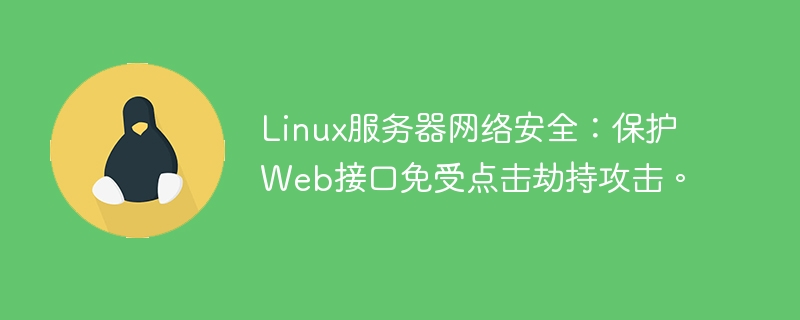Home >Operation and Maintenance >Linux Operation and Maintenance >Linux Server Network Security: Protecting Web Interfaces from Clickjacking Attacks.
Linux Server Network Security: Protecting Web Interfaces from Clickjacking Attacks.
- WBOYWBOYWBOYWBOYWBOYWBOYWBOYWBOYWBOYWBOYWBOYWBOYWBOriginal
- 2023-09-10 14:03:341328browse

Linux Server Network Security: Protecting Web Interfaces from Clickjacking Attacks
Clickjacking attack is a common attack method in the field of network security, which takes advantage of users Trust in click operations, disguise the target clicked by the user as a malicious link or button, thereby inducing the user to click and perform the malicious behavior preset by the attacker. In Linux server network security, protecting web interfaces from clickjacking attacks is an important task. This article will focus on relevant protective measures.
1. Understand the principles of click hijacking attacks
Click hijacking attacks take advantage of the characteristics of the iframe tag and z-index attribute in HTML. The attacker will insert a transparent iframe on his own webpage, and then set the z-index attribute through CSS to cover the visible area of the attacked webpage, make the target webpage transparent, and finally guide the user to click on the attacker's preset button or link.
2. Use X-Frame-Options to defend against clickjacking attacks
X-Frame-Options is an HTTP response header that is used to tell the browser whether to allow the current web page to be embedded in an iframe for display . In general, we can set X-Frame-Options to "DENY" or "SAMEORIGIN" to prevent the page from being nested in an iframe. Among them, "DENY" means rejecting all iframe nesting, and "SAMEORIGIN" means only allowing same-origin web pages to be nested.
On a Linux server, we can set the X-Frame-Options response header by adding the following code in the web server's configuration file:
Header set X-Frame-Options "SAMEORIGIN"
In this way, the web interface can be restricted Nested by non-original web pages, effectively preventing click hijacking attacks.
3. Use Content Security Policy to defend against clickjacking attacks
Content Security Policy (CSP) is an HTTP header field used to increase the security of web applications. By setting the CSP policy in the HTTP response header, you can limit the source of executable JavaScript, CSS, fonts and other resources in the page. In terms of defending against clickjacking attacks, we can use CSP to limit the situation where pages are nested in iframes.
The following is an example of a basic CSP setting:
Header set Content-Security-Policy "frame-ancestors 'self'"
This setting instructs the browser to only allow the current web page to be nested into the same origin web page, thereby preventing malicious web pages disguised by attackers from being iframed. Nested.
It should be noted that CSP settings may need to be customized according to the specific conditions of the web application to ensure that it will not affect normal business operations.
4. Use JavaScript to control jumps
In web applications, we can use JavaScript code to control page jumps to prevent click hijacking attacks. By detecting whether the reference of the top window is itself when the page is loaded, or checking whether the current page is nested in an iframe before triggering the jump, users can be effectively prevented from performing jump operations in a hijacked environment.
The following is a sample code:
if (top.location !== self.location) {
top.location = self.location;
}When it is detected that the current page is nested in an iframe, it will be forced to jump to the top-level window of the current page.
Summary:
Protecting web interfaces from clickjacking attacks is an important task in Linux server network security. By using X-Frame-Options, Content Security Policy, and JavaScript to control jumps, the risk of clickjacking attacks can be effectively reduced. However, it should be noted that network security is an evolving field, and other security measures must be integrated and server software regularly updated and upgraded to ensure the network security of the server.
The above is the detailed content of Linux Server Network Security: Protecting Web Interfaces from Clickjacking Attacks.. For more information, please follow other related articles on the PHP Chinese website!

